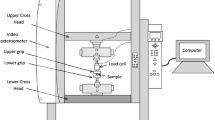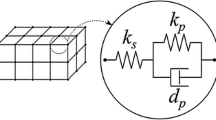Abstract
The extreme stretching of dielectric elastomers in sensors, actuators and energy harvesting devices is a common phenomenon where the materials are prone to fracture under the influence of flaws and notches. In this work, we have investigated the length of flaw sensitivities of two widely used dielectric materials, acrylic (VHB) and silicone (Ecoflex) elastomers under a pure shear loading and established that the length of flaw sensitivity of acrylic is almost double than that of silicone. Therefore, the acrylic elastomer is safer to operate for small notches as compared to the silicone material. However, within the flaw-sensitive length, failure stretch, fracture toughness and failure stress are more for Ecoflex than those for VHB. It is found that the failure stretch and the fracture toughness decrease drastically after the length of flaw sensitivities for both materials. Also, the failure stress keeps on decreasing with an increase in notch length for both materials. Afterwards, a simple phenomenological relation is proposed for fitting experimental results under a pure shear loading with only two parameters. The mathematical relation is valid for both the materials and covers the notch sensitivity with a good agreement.












Similar content being viewed by others
References
An, L., Wang, F., Cheng, S., Lu, T., Wang, T.J.: Experimental investigation of the electromechanical phase transition in a dielectric elastomer tube. Smart Mater. Struct. 24, 035006 (2015)
Zhang, C., Chen, H., Liu, L., Li, D.: Modelling and characterization of inflated dielectric elastomer actuators with tubular configuration. J. Phys. D. Appl. Phys. 48, 245502 (2015)
Mathew, A.T., Koh, S.J.A.: Operational limits of a non-homogeneous dielectric elastomer transducer. Int. J. Smart Nano Mater. 8, 214–231 (2017)
Sahu, R.K., Saini, A., Ahmad, D., Patra, K., Szpunar, J.: Estimation and validation of Maxwell stress of planar dielectric elastomer actuators. J. Mech. Sci. Technol. 30, 429–436 (2016)
Saini, A., Ahmad, D., Patra, K.: Electromechanical performance analysis of inflated dielectric elastomer membrane for micro pump applications. In: Processing of the SPIE, vol. 9798, p. 979813 (2016)
Kumar, A., Ahmad, D., Patra, K.: Dependence of actuation strain of dielectric elastomer on equi-biaxial, pure shear and uniaxial modes of pre-stretching. In: IOP Conference Series: Materials Science and Engineering, vol. 310, p. 012104 (2018)
McKay, T.G., O’Brien, B.M., Calius, E.P., Anderson, I.A.: Soft generators using dielectric elastomers. Appl. Phys. Lett. 98, 1–4 (2011)
Zhao, X., Suo, Z.: Theory of dielectric elastomers capable of giant deformation of actuation. Phys. Rev. Lett. 104, 1–4 (2010)
Koo, I.M., Jung, K., Koo, J.C., Nam, J., Lee, Y.K.: Development of soft-actuator-based wearable tactile display. IEEE Trans. Robot. 24, 549–558 (2008)
Slesarenko, V., Engelkemier, S., Galich, P., Vladimirsky, D., Klein, G., Rudykh, S.: Strategies to control performance of 3D-printed, cable-driven soft polymer actuators: from simple architectures to gripper prototype. Polymers 10(8), 846 (2018)
Mehnert, M., Hossain, M., Steinmann, P.: Experimental and numerical investigations of the electro-viscoelastic behavior of VHB 4905. Eur. J. Mech. A Solids 77, 103797 (2019)
Cohen, N., Oren, S.S., deBotton, G.: The evolution of the dielectric constant in various polymers subjected to uniaxial stretch. Extrem. Mech. Lett. 16, 1–5 (2017)
Schmidt, A., Rothemund, P., Mazza, E.: Multiaxial deformation and failure of acrylic elastomer membranes. Sens. Actuators A Phys. 174, 133–138 (2012)
Huang, J., Shian, S., Suo, Z., Clarke, D.R.: Maximizing the energy density of dielectric elastomer generators using equi-biaxial loading. Adv. Funct. Mater. 23, 5056–5061 (2013)
Hamdi, A., Nait, A.M., Ait, H.N., Heuillet, P., Benseddiq, N.: A fracture criterion of rubber-like materials under plane stress conditions. Polym. Test. 25, 994–1005 (2006)
Pharr, M., Sun, J.Y., Suo, Z.: Rupture of a highly stretchable acrylic dielectric elastomer. J. Appl. Phys. 111, 104114 (2012)
Kaltseis, R.: Natural rubber for sustainable high-power electrical energy generation. RSC Adv. 4, 27905–27913 (2014)
Koh, S.J.A.: High-performance electromechanical transduction using laterally-constrained dielectric elastomers part I: actuation processes. J. Mech. Phys. Solids 105, 81–94 (2017)
Hodgins, M., Seelecke, S.: Systematic experimental study of pure shear type dielectric elastomer membranes with different electrode and film thicknesses. Smart Mater. Struct. 25, 095001 (2016)
Hossain, M., Vu, D.K., Steinmann, P.: A comprehensive characterization of the electro-mechanically coupled properties of VHB 4910 polymer. Arch. Appl. Mech. 85, 523–537 (2015)
Hossain, M., Vu, D.K., Steinmann, P.: Experimental study and numerical modelling of VHB 4910 polymer. Comput. Mater. Sci. 59, 65–74 (2012)
Mehnert, M., Steinmann, P.: On the influence of the compliant electrodes on the mechanical behavior of VHB 4905. Comput. Mater. Sci. 160, 287–294 (2019)
Liao, Z., Yao, X.H., Zhang, L.H., Hossain, M., Wang, J., Zang, S.G.: Temperature and strain rate dependent large tensile deformation and tensile failure behaviour of transparent polyurethane at intermediate strain rates. Int. J. Impact Eng. 129, 152–167 (2019)
Liao, Z., Hossain, M., Yao, X.H., Mehnert, M., Steinmann, P.: On thermo-viscoelastic experimental characterisations and numerical modelling of VHB polymer. Int. J. Non-Linear Mech. (2019) (in review)
Wissler, M., Mazza, E.: Electromechanical coupling in dielectric elastomer actuators. Sens. Actuators A Phys. 138, 384–393 (2007)
Schmidt, A., Bergamini, A., Kovacs, G., Mazza, E.: Multiaxial mechanical characterization of interpenetrating polymer network reinforced acrylic elastomer. Exp. Mech. 51, 1421–1433 (2011)
Goh, Y.F., Akbari, S., Khanh Vo, T.V., Koh, S.J.A.: Electrically-induced actuation of acrylic-based dielectric elastomers in excess of 500% strain. Soft Robot. (2018). https://doi.org/10.1089/soro.2017.0078
Smith, T.L.: Ultimate tensile properties of elastomers. II. Comparison of failure envelopes for unfilled vulcanizates. J. Appl. Phys. 35, 27–36 (1964)
Fan, W., Wang, Y., Cai, S.: Fatigue fracture of a highly stretchable acrylic elastomer. Polym. Test. 61, 373–377 (2017)
Ahmad, D., Patra, K.: Fracture behavior of dielectric elastomer under pure shear loading. In: IOP Conference Series: Materials Science and Engineering, vol. 229 (2017)
Wang, H., Wang, K., Fan, W., Cai, S.: Rupture of swollen styrene butadiene rubber. Polym. Test. 61, 100–105 (2017)
Setua, D.K., De, S.K.: Effect of short fibres on critical cut length in tensile failure of rubber vulcanizates. J. Mater. Sci. 20, 2653–2660 (1985)
Akhtar, S., Bhowmick, A.K., De, P.P., De, S.K.: Tensile rupture of short fibre filled thermoplastic elastomer. J. Mater. Sci. 5, 4179–4184 (1986)
Hamed, G.: Effect of crosslink density on the critical flaw size of a simple elastomer. Rubber Chem. Technol. 56, 244–291 (1983)
Chen, C., Wang, Z., Suo, Z.: Flaw sensitivity of highly stretchable materials. Extrem. Mech. Lett. 10, 50–57 (2017)
Rosset, S., Maffli, L., Houis, S., Shea, H.R.: An instrument to obtain the correct biaxial hyperelastic parameters of silicones for accurate DEA modelling. In: SPIE Smart Structures and Materials, Nondestructive Evaluation and Health Monitoring, vol. 9056, p. 90560M (2014)
Li, B., Zhang, J., Liu, L., Chen, H., Jia, S., Li, D.: Modeling of dielectric elastomer as electromechanical resonator. J. Appl. Phys. 116, 124509 (2014)
Moreira, D.C., Nunes, L.C.S.: Comparison of simple and pure shear for an incompressible isotropic hyperelastic material under large deformation. Polym. Test. 32, 240–248 (2013)
Ahmad, D., Patra, K.: Experimental and theoretical analysis of laterally pre-stretched pure shear deformation of dielectric elastomer. Polym. Test. 75, 291–297 (2019)
Sakulkaew, K.: Tearing of Rubber, Ph.D. Thesis. Queen Mary University, London (2012)
Marano, C., Boggio, M., Cazzoni, E., Rink, M.: Fracture phenomenology and toughness of filled natural rubber compounds via the pure shear test specimen. Rubber Chem. Technol 87, 501–515 (2014)
Acknowledgements
The work was partially supported by DST, Government of India under a research Project No. INT/SIN/P-03.
Author information
Authors and Affiliations
Corresponding author
Additional information
Communicated by Michael Johlitz, Lucien Laiarinandrasana and Yann Marco.
Publisher's Note
Springer Nature remains neutral with regard to jurisdictional claims in published maps and institutional affiliations.
Rights and permissions
About this article
Cite this article
Ahmad, D., Patra, K. & Hossain, M. Experimental study and phenomenological modelling of flaw sensitivity of two polymers used as dielectric elastomers. Continuum Mech. Thermodyn. 32, 489–500 (2020). https://doi.org/10.1007/s00161-019-00817-8
Received:
Accepted:
Published:
Issue Date:
DOI: https://doi.org/10.1007/s00161-019-00817-8




